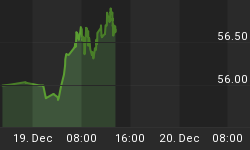The good news is:
• The secondaries continue to outperform the blue chips.
The first chart shows the Russell 2000 (R2K) in red, the S&P 500 (SPX) in green and a FastTrack relative strength indicator called Accutrack as a histogram in yellow. Accutrack has been trending upward (indicating the R2K has been outperforming the SPX) since the late April lows and is well into positive territory.

A summation index (SI) is a running total of oscillator values. The first chart below shows SI's calculated from R2K component advancing issues - declining issues, new highs - new lows and upside volume - downside volume. New highs and new lows were calculated on a trailing 6 week basis rather than a trailing 52 week basis as reported by the exchanges. Summation indices are an intermediate term trend indicator. As of Friday the R2K volume summation index was heading downward while the other two were flat.

The next chart is similar to the one above except is shows the S&P mid cap index in red and the SI's have been calculated from the component issues of the S&P mid cap index. All of the SI's are moving downward.

The next chart is similar to the two above except is shows the SPX in red and the SI's have been calculated from the component issues of the SPX. All of the SI's are moving downward.

It is a positive that the R2K SI's are holding up better than those of the larger cap indices, however the weakness everywhere else suggests caution.
The NASDAQ new high indicator (OTC NH) is a 10% trend (19 day EMA) of NASDAQ new highs. The chart below shows the NASDAQ composite (OTC) in red and OTC NH in green. OTC NH does a pretty good job of indicating the short term market trend and it turned slightly downward as of last Friday's close.

The yellow line in chart below shows the average daily return in July for the OTC since 1963. The white line shows the average daily return during the 1st year of the presidential cycle. The number of trading days varies but there are usually 21. This chart has been constructed by using the first 11 trading days and the last 10. The solid vertical black line indicates the break point. July during the 1st year of the presidential cycle has been quite a bit stronger than the average July. Most of July's gains have been made during the 2nd week.

The chart below is similar to the one above except it shows the SPX using data from 1928. Prior to 1945 the market traded 6 days a week so during that period there have been about 4 trading days cut out of the middle. The chart is similar to the one above except the SPX has made most of its July gains during the 1st week of July rather than the 2nd like the OTC. For both indices and over all periods the high for July has usually occurred about mid month.

Friday's in July have been remarkably strong, especially during the 1st year of the presidential cycle. It is unusual to find days that over an extended period, have been up or down more than 75% of the time. Using the OTC since 1963 during the 1st year of the presidential cycle the average Friday in July has been up 76% of the time. The 76% figure is misleadingly low because a few of the down days have been big bringing down the average. Three of the usually occurring four Fridays have been up 80% of the time or more. The table below includes details for the 1st year of the presidential cycle and summaries for the 1st pres yr and all years combined.
Monthly day of week report for July
Using OTC
In the averages, unchanged is counted as a win.
The number after the year is the position in the presidential cycle.
| Jul Friday's for Pres Yr 1 | ||||||
| Year | 1 | 2 | 3 | 4 | 5 | Totals |
| 1965-1 | 0.73% | 0.83% | 2.06% | -0.42% | 0.74% | 3.94% |
| Avg | .73% | .83% | 2.06% | -.40% | .74% | |
| 1969-1 | -1.37% | 0.79% | -0.13% | -0.72% | ||
| 1973-1 | 0.09% | -0.14% | 1.09% | 0.17% | 1.22% | |
| 1977-1 | 0.17% | 0.53% | 0.48% | 0.40% | -0.03% | 1.54% |
| 1981-1 | 0.24% | 0.35% | 0.77% | 0.76% | 2.12% | |
| 1985-1 | 0.42% | 0.62% | 0.29% | 0.06% | 1.39% | |
| Avg | -.08% | .44% | .51% | .35% | .00% | |
| 1989-1 | 0.65% | 0.23% | 0.01% | 0.08% | 0.96% | |
| 1993-1 | 0.13% | 0.44% | -1.26% | 0.68% | -0.36% | -0.38% |
| 1997-1 | 0.78% | -1.33% | 0.03% | -0.52% | ||
| 2001-1 | -3.65% | 0.44% | -0.84% | 0.30% | -3.75% | |
| OTC Pres Yr 1 Friday averages for the entire database | ||||||
| Avg | -.18% | .28% | .25% | .25% | .12% | 0.14% |
| Win% | 80% | 80% | 70% | 88% | 33% | 76% |
| OTC all Friday averages for the entire database | ||||||
| Avg | .35% | .41% | -.09% | -.15% | .08% | 0.14% |
| Win% | 71% | 76% | 50% | 60% | 42% | 63% |
Most of the indicators are heading downward and seasonally next week is neutral.
I expect the major indices to be lower on Friday July 8 than they were on Friday July 1.
This report is free to anyone who wants it, so please tell your friends. If it is not for you, reply with REMOVE in the subject line.















